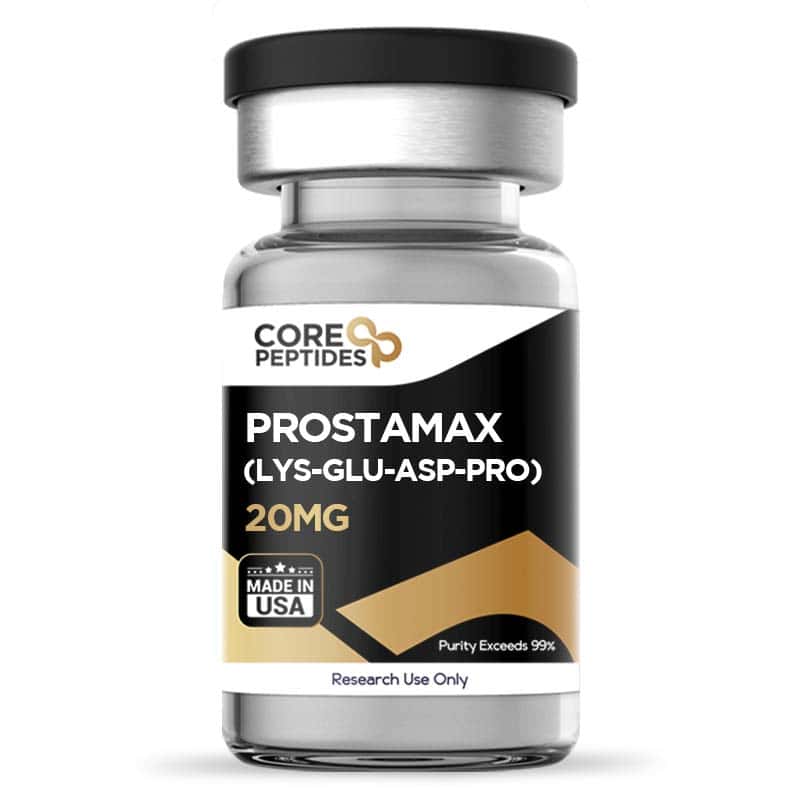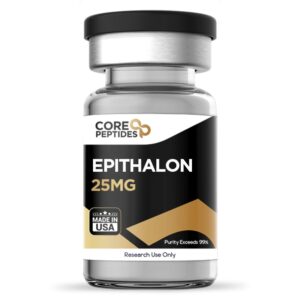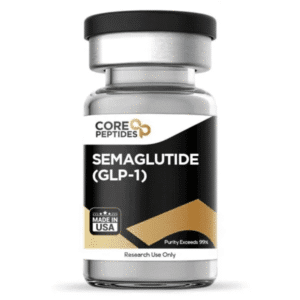Description
Prostamax Peptide – KEDP
Molecular Formula: C₂₀H₃₃N₅O₉
Molecular Weight: 487.5 g/mol
Sequence: Lys-Glu-Asp-Pro
Other Names: KEDP, SCHEMBL6660498
Form: Lyophilized powder
Use: For research and laboratory purposes only; not for human consumption
Overview
Prostamax (KEDP) is a synthetic tetrapeptide classified among the Khavinson peptide family, a group of short peptides investigated for their tissue-repair and bioregulatory potential. Prostamax has been particularly studied for its effects on prostate tissue, chromatin structure, and age-related cellular changes. The peptide appears to influence chromatin dynamics, potentially activating previously repressed genes, increasing sister chromatid exchanges, and modifying nucleolus organizer regions. In prostate cell cultures, Prostamax has shown potential to stimulate reparative processes, reduce inflammation, and prevent sclerotic or atrophic changes, indicating tissue-specific bioregulatory properties.
Chemical Properties
-
Molecular Formula: C₂₀H₃₃N₅O₉
-
Molecular Weight: 487.5 g/mol
-
Amino Acid Sequence: Lys-Glu-Asp-Pro
-
Other Names: KEDP, SCHEMBL6660498
Research and Preclinical Studies
Prostamax and Chromatin Structure
Prostamax has been studied for its potential impact on chromatin architecture, particularly in lymphocytes and aged cells. Evidence suggests that the peptide may modulate chromatin organization, leading to changes in gene accessibility and cellular activity.
-
Thermal Denaturation Studies: One study observed that exposure to Prostamax caused a redistribution of thermal energy between chromatin endotherms (T(d)III and T(d)IV), lowering their temperatures by 2.9°C and 1.0°C respectively. This effect may reflect chromatin relaxation, including decondensation of the 30-nm chromatin fiber into a 10-nm filament. Minor adjustments in nucleosomal organization were also noted, suggesting structural reconfiguration of chromatin in aging lymphocytes.
-
Sister Chromatid Exchanges (SCE) and Nucleolus Organizer Regions (NORs): Research has indicated that Prostamax increases the frequency of SCEs, from an average of 5.9 in control cells to 12.0 exchanges per cell in treated cells. The frequency of Ag-positive NORs also increased from 0.95 in controls to 2.5 per cell, suggesting potential activation of ribosomal RNA gene activity. Additionally, Prostamax reduced the frequency of large C-pericentromeric heterochromatin regions, particularly in chromosomes 1 and 9, reflecting a decondensation or deheterochromatinization effect. These modifications may promote reactivation of genes repressed during aging.
-
Selective Chromosome Action: Further studies propose that Prostamax, alongside other peptides like Epitalon and Livagen, may preferentially modulate chromosome 1 pericentromeric heterochromatin, highlighting potential chromosome-specific bioregulatory actions.
Prostamax and Prostate Tissue
Prostamax has been evaluated in organotypic prostate tissue cultures from both young and aged murine models:
-
Tissue Repair and Anti-Inflammatory Effects: In explant cultures, Prostamax appeared to stimulate reparative processes in prostatic tissue, mitigating age-related deterioration. The peptide potentially reduces chronic inflammation, including vascular hyperemia and lymphoid infiltration, and prevents sclerotic or atrophic changes, suggesting a protective role in maintaining prostate tissue integrity.
-
Chronic Prostatitis Models: Experimental studies in murine models of chronic aseptic prostatitis indicated that Prostamax may reduce inflammatory markers, tissue swelling, and vessel congestion, while potentially improving tissue function and morphology. The peptide appeared to outperform comparator agents in mitigating tissue damage and inflammation, and may also influence sexual behavior in animal models, though further research is needed to clarify this effect.
Conclusion
Prostamax (KEDP) is a synthetic tetrapeptide with potential tissue-specific bioregulatory activity, particularly on chromatin structure and prostate tissue. Preclinical evidence suggests that it may:
-
Promote chromatin relaxation and gene reactivation in aging cells
-
Enhance sister chromatid exchanges and ribosomal gene activity
-
Reduce heterochromatinization in selective chromosomes
-
Stimulate prostate tissue repair and reduce inflammation
-
Mitigate age-related cellular deterioration in targeted tissues
Prostamax remains an experimental peptide for research purposes only and is not approved for therapeutic use in humans.
References
-
Meskhi T, Khachidze D, Barbakadze Sh, et al. Influence of Prostamax on heterochromatin of human lymphocytes in situ. Biofizika. 2004;49(6):1091-1093. Russian. PMID: 15612551.
-
Dzhokhadze TA, Buadze TZh, Gaĭozishvili MN, et al. Deheterochromatinization of chromatin in old age induced by oligopeptide bioregulator (Lys-Glu-Asp-Pro). Georgian Med News. 2012;(212):76-82. Russian. PMID: 23221144.
-
Khavinson VKh, Lezhava TA, Malinin VV. Effects of short peptides on lymphocyte chromatin in senile subjects. Bull Exp Biol Med. 2004;137(1):78-81. doi: 10.1023/b:bebm.0000024393.40560.05. PMID: 15085253.
-
Zakutskiĭ AN, Chalisova NI, Ryzhak GA, et al. Tissue-specific effects of synthetic peptide bioregulators in organotypic tissue culture. Adv Gerontol. 2006;19:93-96. Russian. PMID: 17152728.
-
Borovskaya TG, Pakhomova AV, et al. Experimental study of Prostamax efficiency in chronic aseptic prostatitis. Modern Research in Inflammation. 2013.





Reviews
There are no reviews yet.